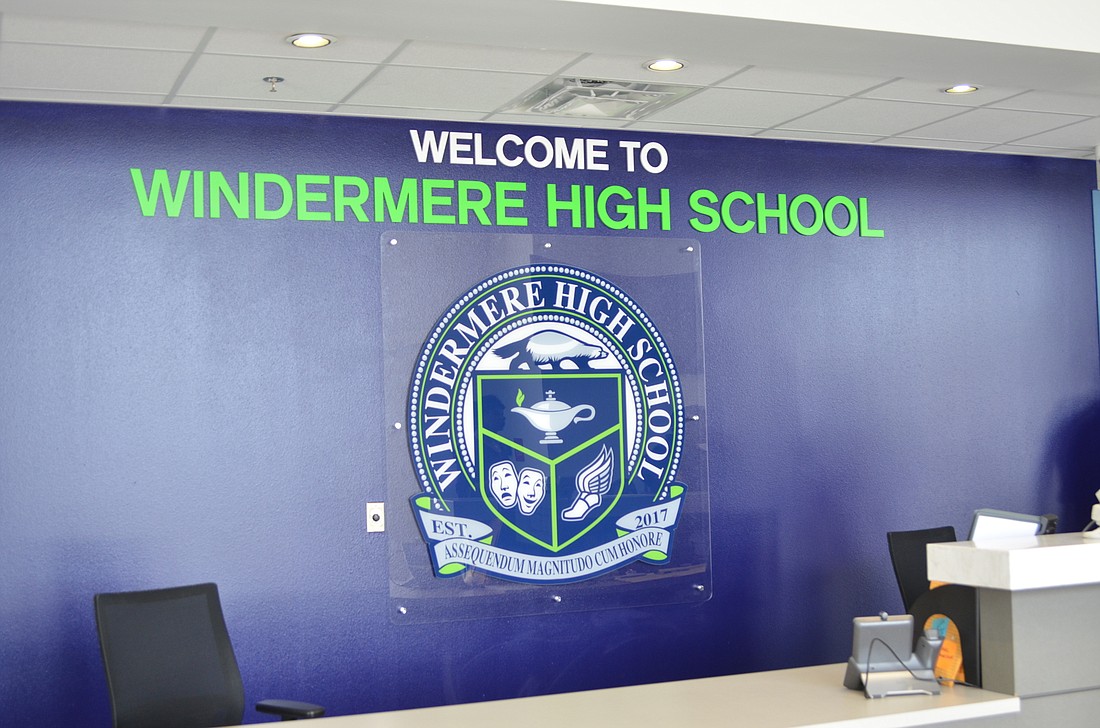- April 12, 2025
-
-
Loading

Loading

HORIZON WEST The rain let up just in time for Windermere High’s big reveal.
It was Wednesday, Aug. 2, and an early-afternoon downpour threatened to ruin the Wolverines’ long-awaited coming-out party. But, the clouds parted with an hour to spare, and within minutes, the halls, courtyards and classroom buildings were filled with future students, parents and community members who, from this day forward, will be known collectively as Wolverine Nation.
As hundreds of sets of impressed eyes took everything in, Douglas Guthrie, Windermere’s inaugural principal, stood in the middle of the courtyard. For Guthrie, this day is more than a year in the making. And despite the gleaming floors, brand-new technology and sparkling cafeteria, he knows the most important aspect of Windermere High — its heart and soul — won’t be fully implemented until Aug. 14.
“It’s not the buildings themselves; it’s the students and the parents and community that will be utilizing these buildings and these walls,” he said. “That’s the uniqueness of each high school — a reflection of the community that it’s in. I miss the students: It’s been 12 months now since I’ve had students, and that’s the heart and soul of the school. That makes it the heart and soul of the principal, too.”
TECHNOLOGY AND AESTHETICS
As is standard with most new OCPS school projects, Windermere High is packed with an array of technology to enhance learning.
Collaborative spaces, labs, the media center and classrooms are equipped with interactive touch-panel television screens, much like SMART boards. All classrooms have audio enhancement, allowing teachers to speak into microphones and be heard anywhere in the room. Crews also will be installing security cameras and card readers on campus. When they are finished, they will have installed 129 cameras throughout the campus.
Windermere High is also a digital-first school, with a one-to-one device ratio that ensures each student has a laptop. There is WiFi throughout the school for seamless internet connection, and the school is built to Green Globe sustainability standards.
“We take into consideration all the products that go into the building, like flooring and paint,” said Tom Widener, project executive with Wharton-Smith Construction Group. “(We look at) things that save energy — plumbing and light fixtures. This campus has a lot more LED fixtures, which is a large energy savings for a campus of this size. Throughout the building, (we do) anything we can do to help lower energy costs.”
Another feature unique to the high school is a 1,000-gallon cistern, housed in the courtyard. It collects rain running from the rooftop, and a pump directly adjacent to it will automatically kick on when there is a demand for irrigation in the school’s greenhouse. If the cistern’s water supply runs low, the irrigation will switch from the rainwater to potable irrigation water.
“We set that up with an indicator so students in the agriculture program can see that when the light is green, it’s running off the cistern (supply),” Widener said. “The idea of putting it in the courtyard is so everyone can see it. That’s the opportunity for the agriculture students to teach other students about the metal can in the middle of their courtyard and teach them about sustainable landscaping and growth.”
As for the architecture, SchenkelShultz Associate Principal Mo Arthur said it’s similar to other OCPS high-school prototypes, but they were able to add even more aesthetically pleasing features.
“On this one in particular we were able to use some features on the exterior like towers, trellises, the formliner in the concrete that gives it that wood look, which is a local Florida characteristic — just those little nuances helps accentuate the architecture of the campus,” Arthur said.
The overall project was expedited to have it ready to relieve West Orange High this year. The process took about 18 months overall, 16 of which were for building. The typical high-school construction timeline is anywhere from 20 to 24 months.
“This project was delivered faster than most of the high-school projects are delivered,” Widener said. “It was fun to be a part of and to partner with the district on it. Sixteen months ago, we were walking out into an orange grove, and to have it look like it does now, that was fun to be a part of it. I like seeing the facility in use. From a construction standpoint we’ve seen it ugly gray, and whenever we get to see it utilized like it’s supposed to be, it’s satisfying.”
BACK TO SCHOOL
When Principal Doug Guthrie looks around the brand-new high school, he can’t wait to see it filled with the students he’s set to lead to success.
“It’s been a real relief to get on campus, be able to walk the campus and see the classrooms and how they’re set up, rather than looking at them on a blueprint or under construction,” Guthrie said. “(It’s great) seeing the furniture and technology in the classrooms and how it’ll work and coordinate together.”
Guthrie spent the previous six years of his career at Apopka High School before being appointed as Windermere High’s inaugural principal in summer 2016. He’s been working hard to help put the pieces of the school puzzle together since last fall and has been hiring teachers and faculty members since January.
“A lot of planning happens — making sure that the course sequence is correct, working with Project Lead The Way’s national curriculum and the equipment and supplies that go along with those courses, making sure they’re ordered,” Guthrie said. “It’s not just one thing. It’s multiple things and coordinating when they will arrive and how they’ll be organized.”
But now, just days before the first bell rings, Guthrie said his staff is ready for to begin Year One.
“We’re going to start school off with teaching in every classroom, and there will be no delays in that,” he said. “I’m very happy to be here and excited to get started.”